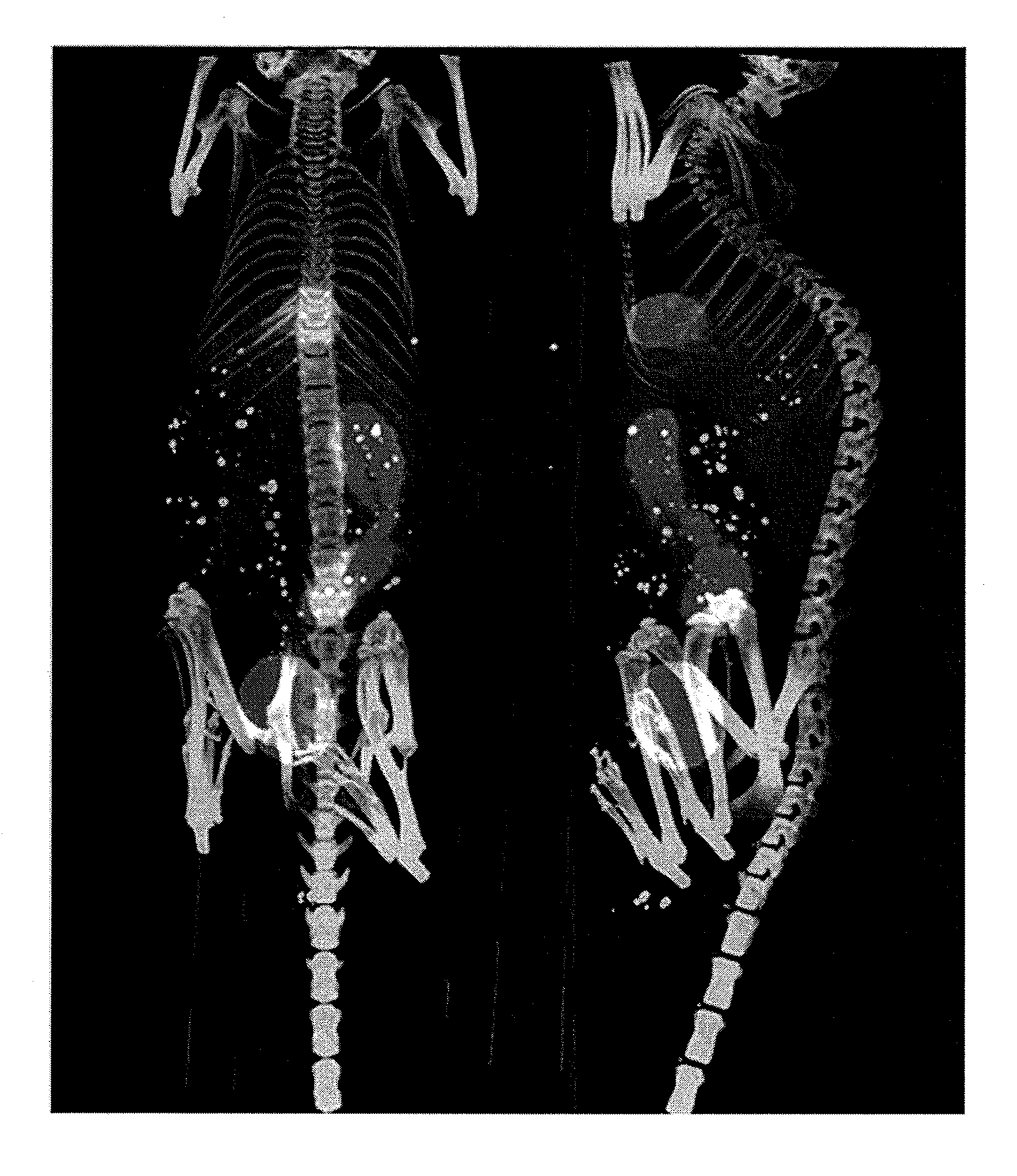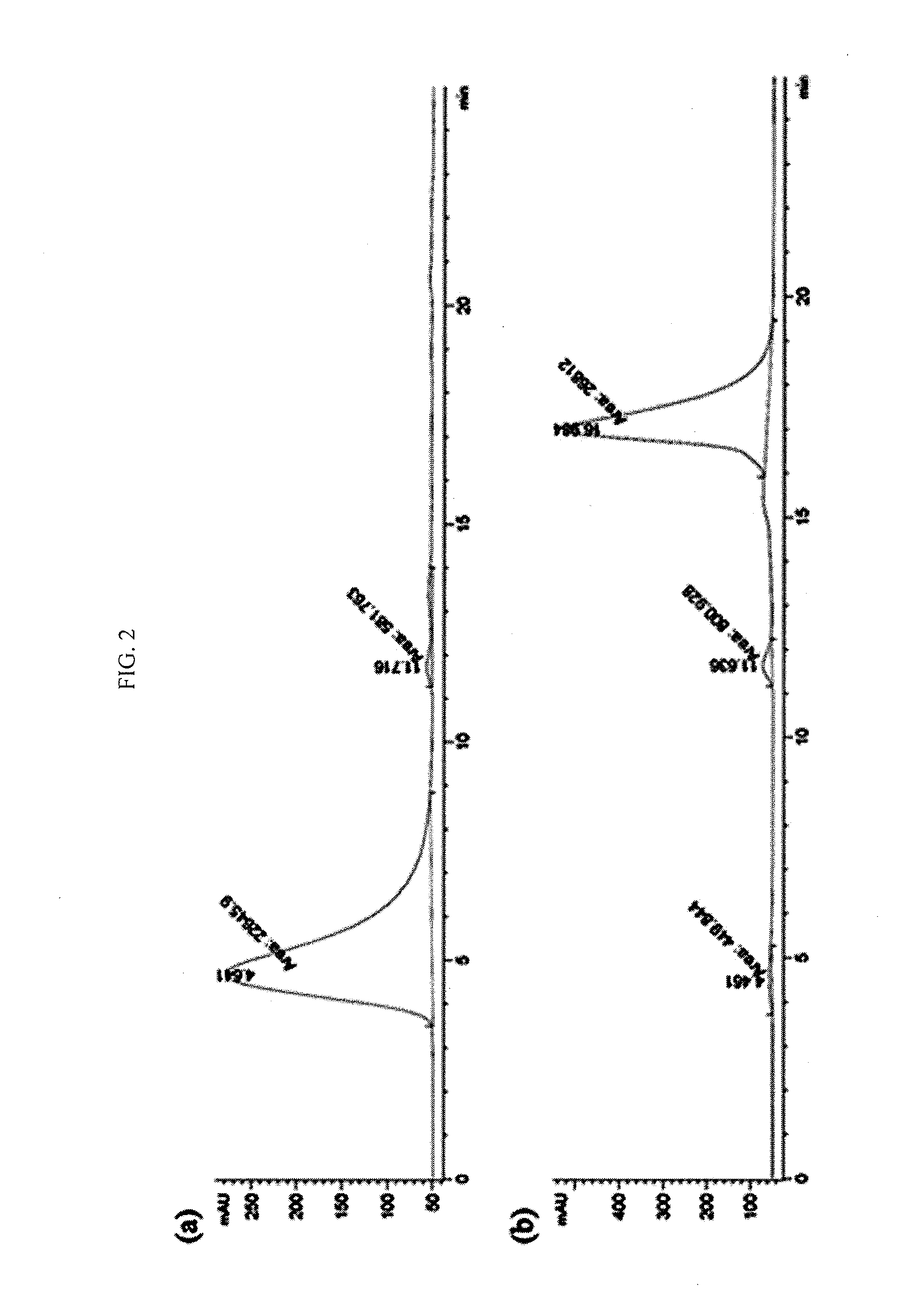Technetium-99m labeled complex of gold nanoparticle-gold binding peptides, and method of making and using the same
a technology of gold nanoparticles and complexes, which is applied in the field of preparing and using the same, and achieves the effect of high labeling yield
- Summary
- Abstract
- Description
- Claims
- Application Information
AI Technical Summary
Benefits of technology
Problems solved by technology
Method used
Image
Examples
preparation example
Preparation of Technetium-99m Labeled Gold Nanoparticles-Gold Binding Peptide According to the Present Invention
[0035]99mTc(CO)3-GBP1-GNP according to the present invention was prepared using the following materials.
[0036]1) materials: 10 nM gold colloid solution (GNP-citrate) was manufactured by Sigma-Aldrich Korea (absorbance of 1.0 at 520 nm, 5.98×1012 particles / ml) and a synthetic gold binding peptide 1 (GBP1, amino acid sequence (SEQ ID No. 1): MHGKTQATSGTIQS) was composed. Sodium pertechnetate (Na 99mTcO4−) was eluted from a 99Mo / 99mTc generator using 0.9% saline.
[0037]2) Experimental animals: Female ICR mice (7 weeks) were obtained from a specific pathogen-free colony at Orient, Inc. (Seoul, Korea) and used after quarantine and adaptation for one week. The animals were raised under 12 hours light / 12 hours dark in a room maintained at a relative humidity of 50±5% and a temperature of 23±2° C., on a standard diet and water ad libitum. The animal experiment according to the pres...
example 1
Determination of Absorbance of GBP1 on the Surface of GNPs
[0039]In order to investigate a minimum concentration of GBP1 required for complete adsorption on the surface of gold nanoparticles (GNPs), since it is known that salts such as NaCl induce aggregation of gold and other nanoparitices (H.M.L. M. Y. Lin et al, Nature, 339, 1989, 360-362), an NaCl-induced aggregation method was used, and concentration of GBP1 adsorbed on the surface of GNPs was analyzed.
[0040]A variety of concentrations of GBP1 were added to 0.5 mL of GNP solution (O.D.=1.0, D=10 nm) to form a mixture, followed by standing for 10 minutes at room temperature. Next, 10% NaCl solution was added to the mixture so as to have a final concentration of 0.5% in order to induce aggregation of GNPs, followed by standing for 10 minutes at room temperature. Subsequently, in order to protect additional aggregation, 0.1% BSA was added to the resultant, followed by standing for 10 minutes at room temperature. Finally, aggregatio...
example 2
Preliminary Experiment for the Preparation of 99mTc(CO)3-Labeled GBP1
[0044]Before preparing 99mTc-GBP1-GNP, a preliminary experiment was carried out to find GBP1 to be labeled with a 99mTc(CO)3 precursor. First, for radio-labeling, 5.9 mg of potassium boranocarbonate, K2[BH3CO]2), 2.85 mg of sodium tetraborate, 8.5 mg of sodium tartrate, and 7.15 mg of sodium carbonate were added to a 5 mL bottle with a stopper, 1 ml of sodium pertechnetate (99mTcO4−, saline, 740 MBq) was added to the bottle using a syringe, and the bottle containing the mixture was heated for 30 minutes at 95° C. in a water bath to produce a 99mTc(CO)3 precursor. Pressure from discharge gas (about 5 mL) was equalized by a 10 mL syringe. Subsequently, the resultant was cooled at room temperature and neutralized by adding 160 μL of 1 N HCl. The prepared 99mTc(CO)3 precursor was reacted with GBP1 at pH 7 and heated for 2 hours at 75° C. Radioactive purity of 99mTc-GBP1 was determined through instant thin layer chromat...
PUM
| Property | Measurement | Unit |
|---|---|---|
| temperature | aaaaa | aaaaa |
| flow rate | aaaaa | aaaaa |
| concentration | aaaaa | aaaaa |
Abstract
Description
Claims
Application Information
 Login to View More
Login to View More - R&D
- Intellectual Property
- Life Sciences
- Materials
- Tech Scout
- Unparalleled Data Quality
- Higher Quality Content
- 60% Fewer Hallucinations
Browse by: Latest US Patents, China's latest patents, Technical Efficacy Thesaurus, Application Domain, Technology Topic, Popular Technical Reports.
© 2025 PatSnap. All rights reserved.Legal|Privacy policy|Modern Slavery Act Transparency Statement|Sitemap|About US| Contact US: help@patsnap.com



